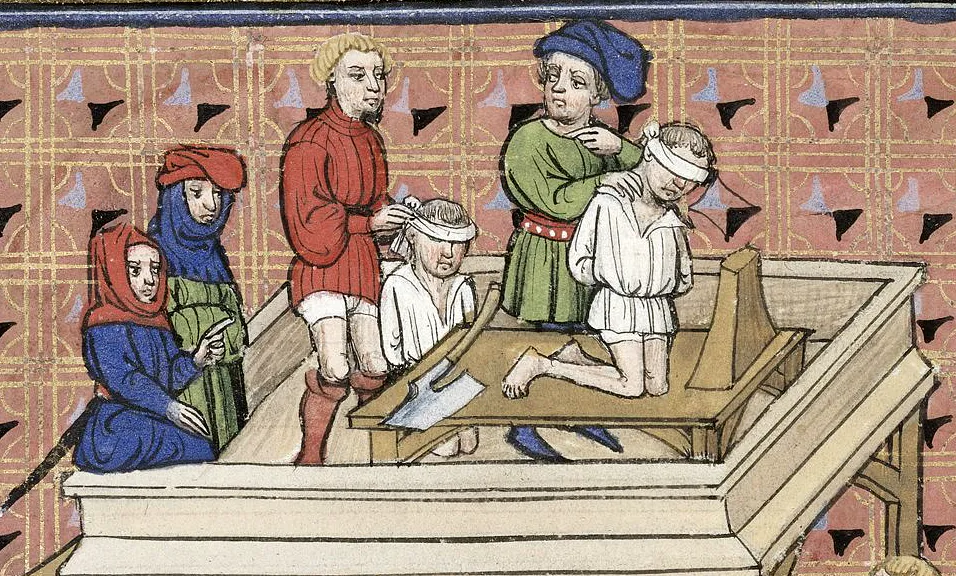Crime and punishment in the Middle Ages were often harsh and unforgiving. Unlike today’s criminal justice system, there was no legitimate police force and the local community was responsible for establishing law and order.
The Christian church also had a large part in determining the punishments for those found guilty. But, they also gave the accused a way to avoid punishment by asking God to save their soul.
Since there were very few prisons during this time, most punishments served to deter others in the community from committing crimes.
While today, the death penalty is very rarely used, it gained great popularity in Medieval times. Similarly, bodily harm is not a sentence used in today’s criminal system.

The Three Ordeals
Trials by jury didn’t become common until the 13th century. Without a formal way of determining someone’s guilt or innocence, the accused were subject to trial by ordeal.
There were three types of ordeals — ordeal by fire, ordeal by water, and ordeal by combat. The goal of these ordeals was to subject the accused to extreme circumstances, and if able to survive, they were seen as innocent in the eyes of God.
Ordeal by fire required the accused to carry a red hot iron 9 feet and then have their hands bandaged. After three days, they were required to show up in court and show their hands.
If the wounds had started to heal, they were considered innocent. If their condition hadn’t improved, they would be found guilty.
There were two different types of ordeal by water. If they were subjected to a cold water ordeal, their hands and feet were tied and thrown into the water. If they began to float, they were considered innocent. But if they sank, they were guilty.
For hot water ordeals, those accused had to retrieve a stone from the bottom of a kettle of boiling water. Similarly to ordeal by fire, if their hands had begun to heal after three days, they were found innocent.
Lastly, ordeal by combat was used to help two parties solve a dispute. This was mostly used when there were no witnesses or confessions to a crime. Two individuals would fight in combat, and the winner would be declared innocent.
While brutal, these ordeals were used to justify God’s will in the criminal justice system. If the accused could survive or be found innocent after their ordeals, it was believed they had been given power from God.
Common Crimes and Punishments
As society has evolved, the type of crimes committed and their equivalent punishments have significantly changed. Here are some of the common crimes and punishments of medieval times.
Petty Theft
Stealing was one of the most common crimes committed during the Middle Ages. Petty theft relates explicitly to the theft of low-value goods from an individual or business. Depending on the severity of the theft, the consequences could range from public humiliation all the way up to bodily mutilation.
The most common punishment for those found guilty of stealing was extra work or fines. According to the thievery code in the book of Dalarna, the fine could range from three to 40 marks.
While inconvenient, being fined was not nearly as embarrassing or dishonorable as the more serious punishments. Those guilty of “full thievery” could be hanged or suffer a more painful fate like bodily dismemberment.
It wasn’t uncommon for a thief’s hands or ears to be cut off, signaling to everyone they were a criminal.
Arson
Deliberately setting fire to a building could severely affect the community during Medieval times. Even small fires could easily spread across multiple houses since buildings at the time were made of wood and straw.
Since this type of crime could have a major impact, criminals found guilty of arson were subject to capital punishment.
Capital punishments are equivalent to the death penalty and result in the individual being executed, usually by hanging. This was considered the most serious of punishments as it often impacted the ruling classes property or land.
Treason
Treason is the act of being disloyal to the crown that ruled at the time. This could include something as serious as attempting to murder a monarch, but it also could include speaking badly of the royal family.
Those found guilty of treason faced the most serious punishment — no matter the severity of the crime. In 1351, the punishment for treason became enshrined in the legal code.
This punishment involved a gruesome death. The culprit was often hung from a tree but cut down before their death. Once down from the tree, an executioner would behead them, dismember their body, and ship body parts to other areas. The body parts would be displayed and serve as a warning against those considering a similar crime.
Murder
Murder remains one of the most serious crimes in common-day crime and punishment. But it also was equally as serious in medieval times.
Since there was no DNA or modern technology to help solve murders, many went unsolved. While it was more common in centuries past, those found guilty of murder were punished by death.
However, women found guilty faced a more brutal death than just meeting the executioner. If a woman was found to have murdered someone, they would be hung or strangled and then burnt.
Stealing crops
Different from petty theft, stealing crops was viewed as a more serious offense than the simple pickpocketing that occurred. At the time, food was such a valuable asset that took great effort to harvest and maintain.
Those found guilty of stealing crops from someone’s land often had their hand removed, preventing them from stealing anymore and making them a public spectacle to others.
Crops were often stolen from high-ranking lords who owned land, ensuring the ruling elite had control over the punishment of the low, poorer class.

